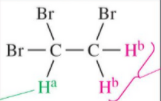Chemistry
10th Edition
ISBN:9781305957404
Author:Steven S. Zumdahl, Susan A. Zumdahl, Donald J. DeCoste
Publisher:Steven S. Zumdahl, Susan A. Zumdahl, Donald J. DeCoste
Chapter1: Chemical Foundations
Section: Chapter Questions
Problem 1RQ: Define and explain the differences between the following terms. a. law and theory b. theory and...
Related questions
Question
Please answer 22 based off of #21 and the picture provided. Thank you!

Transcribed Image Text:Br
Br
Br — С — С—
На
Hb
6.0
5.5
5.0
4.5
4.0
3.5
8 (ppm)
O 2013 Pearson Education, Inc.
16. In the above spectrum, why are there two signals?
17. Why is Ha more downfield than H,?
18. What would you expect to be the area under the curve for Ha? What would you expect to
be the area under the curve for Hp? That is, what would you expect their integration ratio to
be?
19. For Ha, how many non-equivalent protons are on the adjacent carbon atoms (that is, how
many non-equivalent protons are 3 bonds away)?
20. How does the answer in question 19 explain the splitting pattern of Ha? Does the splitting
pattern of Ha follow the N+1 Rule?
21. For Hp, how many non-equivalent protons are on the adjacent carbon atoms (that is, how
many non-equivalent protons are 3 bonds away)?

Transcribed Image Text:22. How does the answer in question 21 explain the splitting pattern of H,? Does the splitting
pattern of Hp follow the N+1 Rule?
Expert Solution
Step 1
Given compound,

Step by step
Solved in 2 steps with 1 images

Knowledge Booster
Learn more about
Need a deep-dive on the concept behind this application? Look no further. Learn more about this topic, chemistry and related others by exploring similar questions and additional content below.Recommended textbooks for you

Chemistry
Chemistry
ISBN:
9781305957404
Author:
Steven S. Zumdahl, Susan A. Zumdahl, Donald J. DeCoste
Publisher:
Cengage Learning

Chemistry
Chemistry
ISBN:
9781259911156
Author:
Raymond Chang Dr., Jason Overby Professor
Publisher:
McGraw-Hill Education

Principles of Instrumental Analysis
Chemistry
ISBN:
9781305577213
Author:
Douglas A. Skoog, F. James Holler, Stanley R. Crouch
Publisher:
Cengage Learning

Chemistry
Chemistry
ISBN:
9781305957404
Author:
Steven S. Zumdahl, Susan A. Zumdahl, Donald J. DeCoste
Publisher:
Cengage Learning

Chemistry
Chemistry
ISBN:
9781259911156
Author:
Raymond Chang Dr., Jason Overby Professor
Publisher:
McGraw-Hill Education

Principles of Instrumental Analysis
Chemistry
ISBN:
9781305577213
Author:
Douglas A. Skoog, F. James Holler, Stanley R. Crouch
Publisher:
Cengage Learning

Organic Chemistry
Chemistry
ISBN:
9780078021558
Author:
Janice Gorzynski Smith Dr.
Publisher:
McGraw-Hill Education

Chemistry: Principles and Reactions
Chemistry
ISBN:
9781305079373
Author:
William L. Masterton, Cecile N. Hurley
Publisher:
Cengage Learning

Elementary Principles of Chemical Processes, Bind…
Chemistry
ISBN:
9781118431221
Author:
Richard M. Felder, Ronald W. Rousseau, Lisa G. Bullard
Publisher:
WILEY